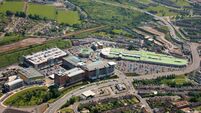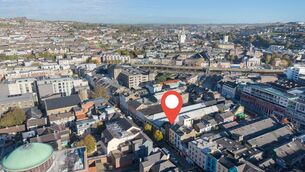Historic site of 19th-century 'spa breaks' on offer for €1.5m

Artist’s impression of the proposed design for The Hydro nursing home. The 12-acre site near Blarney, which once housed the original ‘Roman-Irish’ baths, is now on the market for €1.5m. The proposal, which went to An Bord Pleanála, was given the go-ahead with conditions, including that provision be made to incorporate some elements of the former Hydropathic Establishment.
A 12-acre site synonymous with providing pioneering health treatments is on the market near Blarney with a guide price of €1.5m and full planning permission for a state-of-the-art nursing home.
Hydro Estates Ltd, headed by local businessman Michael O’Regan, has planning for a 120-bed nursing home at the site of the former St Anne’s Hydropathic Establishment, the first Roman-Irish baths in western Europe.
Hydro Estates also has permission for more than 20 housing units on the site at St Anne's Hill, Kilnamucky Tower, Blarney, but that permission does not form part of this sale.

Pat Falvey, who is handling the land sale on behalf of Coldwell Banker Carlton Estates, said Hydro Estates intends to build the 21 detached homes themselves.
The proposed nursing home, at ‘The Hydro’, has been designed by Deady Gahan Architects and has a total floor area of 8725 sq m, or almost 94,000 sq ft.
Mr Falvey said the building design makes it suitable “for both general or dementia-related nursing needs”.
Bedrooms are single, ensuite, and arranged around internal courtyards.
He said that whoever builds the two-storey nursing home can expect it to cost in the region of €20m to complete.
When the reported in 2018 that the planning application had been lodged, the team driving the project said heads of terms had already been agreed with a national nursing home operator.
However, Mr Falvey said this had not come to pass.
They had, however, taken input from nursing home operators while working on the project, and some of those were “live and interested”, he said.
Mr Falvey said there were “a number of ways in which the project could take shape”, including that an operator could come on board and take it over, or that an operator and a developer could come in as a joint venture, or that an investor might join the party.
The proposal, which went to An Bord Pleanála, was given the go-ahead with conditions, including that provision be made to incorporate some elements of the former Hydropathic Establishment, which is a protected structure.
As part of this commitment, a belfry clock tower is included in the design, although Mr Falvey said the original is in a poor state.
He said it was always intended that the development would take account of the site’s “significant past”, “hence the reinstatement of the clock tower and elements of the original structure such as external walls of old buildings, to be retained and reconstructed”. The site’s “significant past”, (as per abandonedireland.com), outlines how local doctor Richard Barter became interested in water as a treatment for ill health after the 1832 cholera epidemic.
After extensive research and several failed attempts, he eventually developed an “improved Turkish bath” — a forerunner to Irish-Roman baths found around Europe today.
Ultimately, his establishment turned out to be quite a tourist attraction, for what we might in hindsight term “spa breaks”.
Mr Falvey said that back in the day, the site had been well served by the Muskerry Tram Line and that good transport links of a different nature remain today in the form of a bus service every 20 minutes between Blarney, Cork City and Mahon.
Mr Falvey said the site is “a unique opportunity to obtain a strategic site that meets all the needs of modern nursing requirements, in a picturesque location ... just 10km north-west of Cork City".










